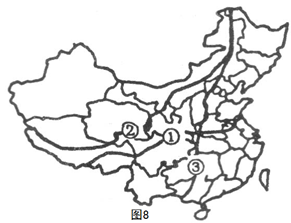问题
选择题
图中①、②、③是我国几条重要的地理界线,下列有关界线①、②、③的叙述正确的是:

A.①是我国全年均温00C等温线,③是我国地势三级阶梯分界线
B.②为季风界线,③为第二、三级阶梯(地形)界线
C.②为森林与非森林分界线,③季风区和非季风区分界线
D.②为400毫米年降水量界线,③为农牧业界线
答案
答案:B
本题考查我国的区域分界。图示①线大约与我国800mm年等降水量线重合(也是冬季0°C等温线);②表示我国的季风区与非季风区的分界线;③表示我国地势第二、三级阶梯分界线。故选B项。
